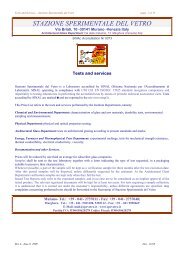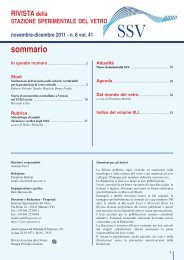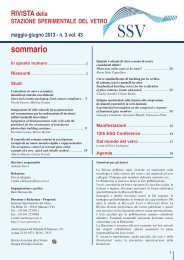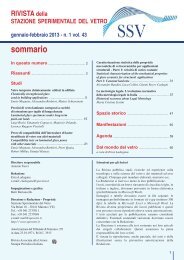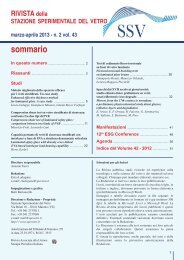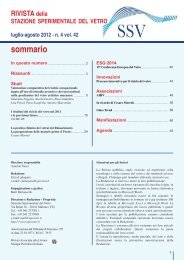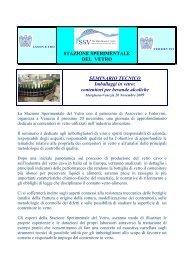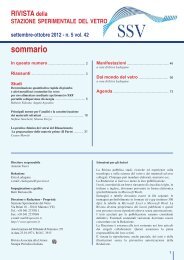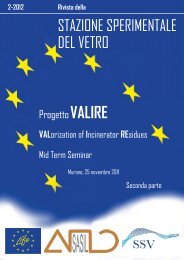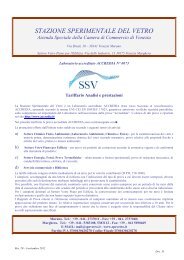RSSV 4 2013.indd - Stazione Sperimentale del Vetro
RSSV 4 2013.indd - Stazione Sperimentale del Vetro
RSSV 4 2013.indd - Stazione Sperimentale del Vetro
Create successful ePaper yourself
Turn your PDF publications into a flip-book with our unique Google optimized e-Paper software.
4-2013<br />
studies<br />
studi<br />
Rivista <strong>del</strong>la <strong>Stazione</strong> <strong>Sperimentale</strong> <strong>del</strong> <strong>Vetro</strong><br />
5. Can edge-coating removal cause any problem?<br />
Since very high “I” and “Li” values were reported<br />
in some cases, it was necessary to check if this was<br />
only due to the warm-edge spacer. To investigate<br />
this, we have tested samples with warm edge and<br />
with aluminium spacer both with removed L.E.<br />
glass produced in the same time in different factories.<br />
“Butterfly tests” are carried out on a regular basis<br />
by these manufacturers and the edge-coating removal<br />
turned out to be always effective, because of<br />
the good adhesion between the glass and the sealant.<br />
The test outcomes showed that, for at least 10 producer<br />
over 20, I and Li values were very high even<br />
with aluminum spacers for manufacturers whose I<br />
values had always been close to 5% for at least 10<br />
years and Li values between 0.5 and 0.8 for I.T.T.<br />
Some samples fitting both warm-edge spacers and<br />
aluminum spacers with low-emission glass showed<br />
a permanent glazing unit deformation along the<br />
sealed edge of the low-emission sheet, after the ageing<br />
cycle. Figures 7 and 8 show the double glazing<br />
with a composition of 4/15/4 mm (with an expected<br />
overall thickness of about 23 mm).<br />
Figures 7. 8. Sealant deformation on an IGU:<br />
with warm-edge spacer; with aluminum spacer<br />
By way of example, table 2 shows the thickness after<br />
ageing of a standard IGU measured on the corners<br />
and at the center of the sides. A difference in thickness<br />
between the minimum and the maximum value<br />
is pointed out, in the order of 2 mm. Although the<br />
external sealant does not lose adhesion to the glass<br />
surface, it has undergone a permanent deformation<br />
on the low-emission glazing side.<br />
Comparing these values with those of another glazing<br />
unit in table 3 and figure 9 , it can be noticed that<br />
in this case deformation occurred to a greater degree<br />
in corner No. 4, and not at the center as in the previous<br />
example.<br />
It is necessary to analyze more thoroughly the interaction<br />
between the external sealant, the type of<br />
grinder and the coating removal process.<br />
It is necessary to point out that the phenomenon:<br />
- occurred with different grinder types and edgecoating<br />
removal methods;<br />
- does not depend on the type of low-emission<br />
glazing;<br />
- does not develop evenly on all sealant materials.<br />
Conclusions<br />
Our findings have proved that the outcomes of gas<br />
leakage tests with “rigid” warm-edge spacers improved<br />
with time. This is due to a greater knowledge<br />
of the critical issues and to the changes in the usage<br />
of this material. The penetration index tests, instead,<br />
have not highlighted significant improvements yet, to<br />
reach the low level we had with traditional materials.<br />
Although the results of our tests on “flexible” warmedge<br />
spacers were not reported herein, at present<br />
only one tested glazing unit over five passes the gas<br />
leakage (Li %) test (that is 20% success).<br />
The edge-coating removal process, which is now<br />
carried out on nearly all double glazing units, has<br />
proved to be a high risk factor to successfully pass<br />
the tests.<br />
Unfortunately, EN 1279/2 and 1279/3 allows system<br />
validation for CE by testing glazing units with<br />
10



